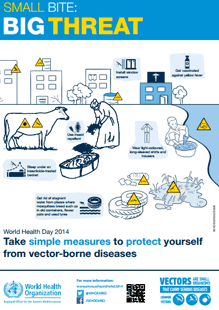 3 April 2014 – The aim of World Health Day 2014 is to raise awareness of the problem of vector-borne diseases and encourage individuals and communities to take action to protect themselves against the vectors that cause disease. Vectors are organisms that transmit pathogens and parasites from one infected person (or animal) to another, putting health at risk, at home and during travels.
3 April 2014 – The aim of World Health Day 2014 is to raise awareness of the problem of vector-borne diseases and encourage individuals and communities to take action to protect themselves against the vectors that cause disease. Vectors are organisms that transmit pathogens and parasites from one infected person (or animal) to another, putting health at risk, at home and during travels.
Vector-borne diseases account for 17% of the estimated global burden of all infectious diseases. Malaria is the most deadly vector-borne disease, causing an estimated 660 000 deaths in 2010. Every one minute a child dies of malaria.
Yellow fever and dengue fever are also fatal diseases; dengue fever is the world's fastest growing vector-borne disease with a 30-fold increase in disease incidence over the last 50 years.
Dr Ala Alwan, WHO Regional Director for the Eastern Mediterranean, outlined some of the main challenges of preventing vector-borne diseases, including the lack of vaccines to protect people against these diseases. “But there are things people can do to protect themselves. Keep the environment clean. Use personal protection, such as insect repellent. Sleep under bednets, cover water containers, and get rid of stagnant water from places where mosquitoes breed, such as unused containers, flower pots, old tyres, broken glass and roof gutters.” He added, “Collaboration between different sectors is essential to control vectors and protect people from disease. Ministries of health, agriculture, irrigation and municipalities, as well as communities, need to work together to implement an integrated vector management approach. In this way we can tackle more than one disease at a time, and focus on reducing the use of chemicals to control vectors. A joint approach is more effective, more cost-efficient, more environmentally sound and more sustainable than when each sector works alone”.
Although a vaccine does exist for yellow fever there are an estimated 200 000 cases worldwide each year, and about 30 000 of those with yellow fever will die, as there is of yet no cure.
Some vector-borne diseases, such as leishmaniasis, onchocerciasis (river blindness) and filariasis, disfigure those infected, often resulting in social stigmatization and exclusion.
Vector-borne diseases are common in tropical and sub-tropical areas where safe drinking-water and safe sanitation systems are not accessible. Over the years, climate change, population movement, uncontrolled urbanization, poor housing and lack of safe water and sanitation have all contributed to the spread of vector-borne diseases.
On World Health Day, WHO urges governments to ensure that they have strong surveillance systems and that proper and rapid diagnosis and treatment are available to save lives. “WHO is always ready to support. We must build on the experiences of the past, sustain our commitments, and accelerate our efforts to control and eliminate these diseases in our Region. Let us make this World Health Day a day to scale up efforts to control the very big threat caused by a small bite,” said Dr Alwan.
Related links



